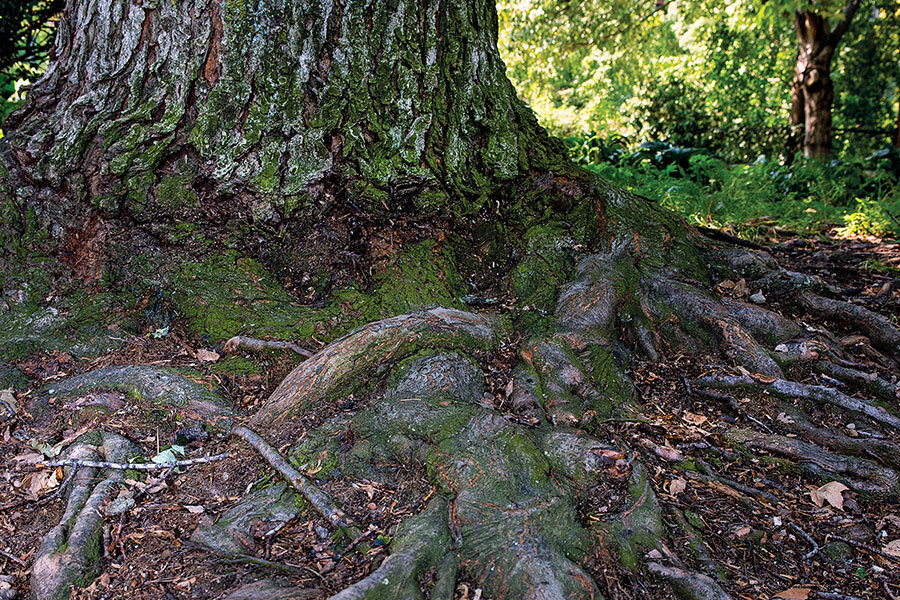How you should really plant a tree
Loading...
Maybe money does grow on trees: Scientists in Australia recently found gold particles in eucalyptus leaves, drawn up through the roots from underground deposits. Trees have also been in the news for another reason. Our idea of how tree roots grow has been wrong: They mainly grow out, not down.
Most of a tree’s roots – the large woody roots and the fine feeder roots – lie in the top foot of soil. (As soil depth increases, soil becomes more compact, colder, and contains less oxygen and minerals.) Taproots rarely descend more than seven feet. There are differences among tree species, but most tree roots extend well past the tree’s drip line (the outermost circumference of leaves), up to four times the diameter of the canopy.
This has led to new counsel on planting trees. The advice on determining suitable sun or shade, avoiding overhead obstacles, and not planting too close to buildings hasn’t changed, but you should be more wary about far-roaming roots. Trees set too close can lift sidewalks and driveways, invade sewer pipes and septic systems, and damage foundations. Set too close to play and high-traffic areas, a tree can suffer root damage.
The old practice was to dig halfway to China when planting a tree. But we now know that trees do best when planted in shallow holes shaped like upside-down umbrellas that are three to four times as wide as but no deeper than the root ball or root mass. (In heavy soils, set trees slightly higher than they were growing, or “plant proud,” as the British say.)
I’m a fan of buying small trees, four feet tall, tops. They’re cheaper, easier to plant, and recover more quickly when transplanted. (Research indicates that small trees often outgrow larger ones in only a few years.) Trees to plant can arrive three ways:
Bare-root trees are field-grown, dug when small, and stored without soil around their roots. By far the least expensive, they are also easy to handle and, because they have more root mass, quickly adapt to a new site. They can be ordered for fall or spring delivery. Soak roots in water for 24 hours before planting.
Ball-and-burlap trees are available throughout the year. Field-grown, they are dug with a ball of soil around the roots that is wrapped and tied in burlap or other material. The B&B method is used for medium to large trees. Note that a 20-foot tree may have a ball five feet across and weigh half a ton. Remove all wrapping before planting. (Exception: an openwork wire cage, which can be left in place. Consult the tree nursery.)
Container-grown trees, also available year-round, range from small to medium in size. They are grown and sold in large pots. Because they aren’t dug, they don’t lose root mass, but they can become rootbound if potted too long. Ask the seller to remove the container so you can examine the roots; if they are circling inside the pot, don’t buy the tree.
Trees are best planted during the dormant season – before bud break or after leaf drop. Plant any tree as soon as you buy it to keep the roots from drying out. Here’s what to do:
1. Dig a wide, shallow hole with tapering sides; keep the soil.
2. The hole’s depth should allow the tree to be at the same level it was at when it was growing. (The trunk flare, where the roots grow out from the trunk, should be just visible after backfilling the hole.) Remove the container (if there is one) and cut away and remove any material surrounding the root ball.
3. If the roots are girdling, circling, or kinking, try to untangle them. Check from all sides that the tree is straight.
4. Begin filling the hole with the reserved soil. (Do not amend with compost unless soil is extremely poor or compacted.) When the hole is half full, fill with water. Let the water drain completely, then finish backfilling to the trunk flare. Do not overpack the soil.
5. Unless the location gets gale-force winds or the tree cannot stand upright without support, do not stake. (Trees develop stronger trunks and roots when not staked.) Do not use tree wraps, which can trap moisture. Prune only broken or dead branches. Do not fertilize, as feeding encourages foliage growth at the expense of needed root development.
6. Apply a three-inch-deep mulch of wood chips, bark, pine needles, or other organic matter over the planting hole. Leave two or three inches between the mulch and the tree trunk.
Water the tree deeply and regularly for the first six months – twice a week or more – or use a drip irrigation bag. Keep the tree mulched and weeds pulled.
Why a tree? Trees increase your home’s value. They reduce soil erosion, absorb carbon dioxide, release water vapor and oxygen, cast shade, block wind, muffle sound, and feed and harbor wildlife. Trees are as good as gold.







